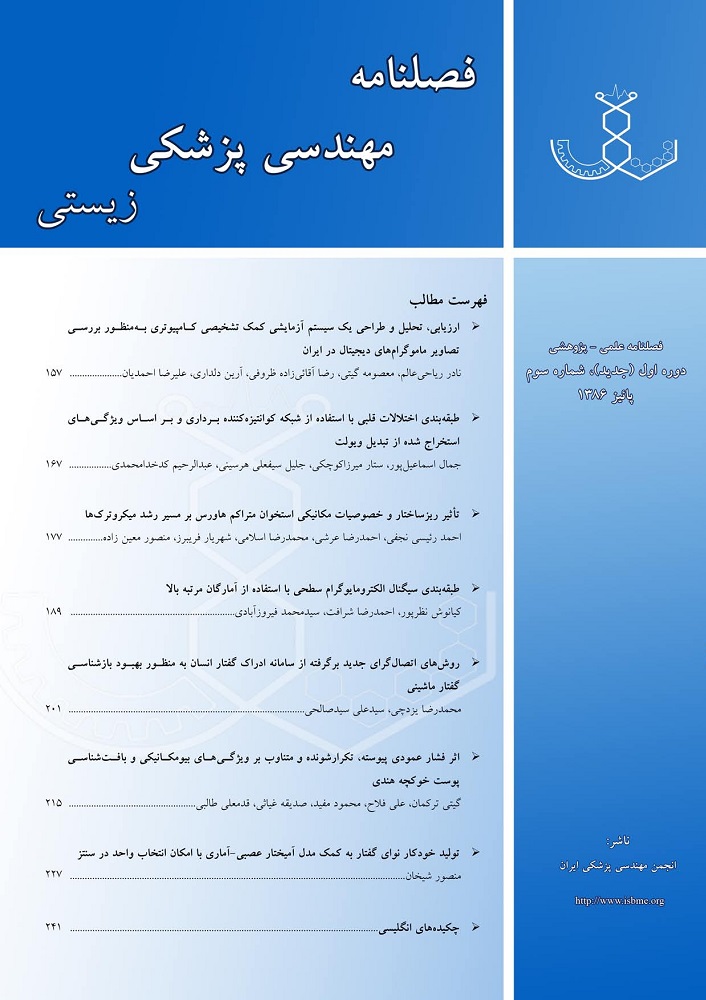نوع مقاله : مقاله کامل پژوهشی
نویسندگان
1 دانشیار گروه فیزیوتراپی، دانشکده علوم پزشکی، دانشگاه تربیت مدرس
2 استادیارمهندسی پزشکی، دانشکده مهندسی پزشکی، دانشگاه صنعتی امیرکبیر
3 مربی گروه علوم تشریح، دانشکده پزشکی، دانشگاه علوم پزشکی بقیه الله
4 کارشناس ارشد گروه فیزیوتراپی، دانشکده علوم پزشکی، دانشگاه تربیت مدرس
5 استادیار گروه فیزیوتراپی، دانشکده توانبخشی، دانشگاه علوم پزشکی تبریز
چکیده
در این مطالعه از 22 خوکچه هندی نر از نژاد آلبینو 4 تا 6 ماهه به وزن 400 تا 450g استفاده شده است. فشار کنترل شده به وسیله ایندنتور کنترل شونده با کامپیوتر، بر پوست ناحیه برجستگی استخوان ران اندام عقبی حیوان اعمال شد. میزان فشار 291 mmHg بود که به مدت 3 ساعت در سه گروه به صورت پیوسته (3 ساعت)، تکرار شونده (دو دوره 90 دقیقه ای اعمال فشار با فاصله یک روز) و متناوب (دو دوره 90 دقیقه ای به فاصله 15 دقیقه) اعمال شد. پس از 7 روز نمونه های بافتی از محل اعمال فشار برای انجام آزمایش های بیومکانیکی و بافت شناسی تهیه شد. در گروه فشار پیوسته آثار نکروز عضلانی کاملا مشهود بود اما در دو گروه دیگر آسیب و نکروز بافتی مشاهده نشد. تحلیل نتایج پارامترهای بیومکانیکی بافت نیز نشان داد، حداکثر تنش، سفتی، کرنش و سطح زیر منحنی نیرو- تغییر طول در گروه فشار پیوسته کاهش معنادار داشته است. به نظر می رسد اعمال فشار به صورت پیوسته، ایسکمی بیشتری نسبت به فشار تکرار شونده و فشار تناوبی در بافت ایجاد کرده است از این رو تغییرات بیومکانیکی پوست و نکروز عضلانی در این نوع اعمال فشار بیشتر بوده است.
کلیدواژهها
موضوعات
عنوان مقاله [English]
Effect Of Continuous, Repeated And Intermittent Pressure On The Biomechanical And Histological Characteristics Of Guinea Pig Skin
نویسندگان [English]
- Giti Torkamaan 1
- Ali Fallah 2
- Mahmoud Mofid 3
- Sedighe Ghiasi 4
- Ghadam Ali Talebi 5
1 Associate Professor, Physical Therapy Department, Medical Sciences School, Tarbiat Modares University
2 Assistant Professor, Biomedical Engineering School, Amirkabir University
3 Instructor, Anatomy Department, Medical School, Baghiyatallah University of Medical Sciences
4 MSc Graduated, Physical Therapy Department, Medical Sciences School, Tarbiat Modares University
5 Assistant Professor, Physical Therapy Department, Rehabilitation School, Tabriz University of Medical Sciences
چکیده [English]
In this study 22 male Guinea Pigs, 4-6 months old, weighting 400-450 g were used. A computer controlled indentor system was used to apply a controlled pressure. The applied pressure was 291 mmHg for 3 hours over the trochanter region of animal hind limb. The animals were divided in three groups; in group 1, pressure was applied 3 hours continuously, in group 2, pressure was applied 90 minutes at two days and in group 3, Pressure was applied in two cycles of 90 minutes with 15 minutes rest between them. To study the biomechanical and histological changes, tissue was removed 7 days after pressure application. Uniaxial tensile test was performed at a deformation rate of 20 mm/min. In this test, the contralateral site on the experimental animal served as intra-animal control. Tissue biopsy was taken and stained with H&E and Trichorome for histological examination. Continuous pressure induced muscle necrosis. Also ultimate stress, stiffness, ultimate strain and area under the load-deformation curve decreased significantly. These results suggest that application of continuous pressure is the major cause of ischemia and necrosis of soft tissue.
کلیدواژهها [English]
- External Pressure
- Ischemia
- Skin
- Biomechanical Characteristics
- Tensile strength

